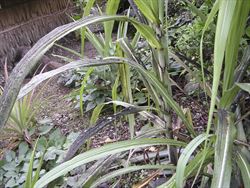- Restricted. Asia, Oceania. In Fiji, PNG, Solomon Islands.
- Major damage reported from India, China. Reduced yields and sugar content; sooty mould growth on honeydew. Transmits Sugarcane yellow leaf virus, causing important emerging disease.
- Adults produce living young without fertilisation – males rare.
- Nymphs, oval, greenish-white or greenish-yellow, later stages covered in powdery wax; when mature, 2mm long, 1.5mm wide. Adults slightly larger, also covered in white wax. Winged adults produced when colony large or food scarce.
- Spread: aphids by flight, and on the wind. On canes, sent to the mill and sets used for planting.
- Biosecurity: risk from unofficial introductions of aphid-infested sets. Official movement of germplasm should always follow the FAO/IPBGR Technical Guidelines.
- Biocontrol: Coccinellid, Synoycha grandis, reared and released in China. Parasitoids known from Indonesia, Philippines), and predators (lacewing and pyralid moth) mass-reared (India).
- Cultural control: avoid planting sets from aphid- infested fields; apply organic fertilisers and manures rather than synthetic products; if practical, remove infested leaves; collect and burn trash after harvest.
- Chemical control: dip sets in hot-water, 50oC for 30 mins; avoid broad-spectrum insecticides; use biorational insecticides (smallholders: neem, derris, chilli, pyrethrum; alternatively, white oil, soap or horticultural oil); use mycopesticide, Metarhizium anisoliae. If ants protecting aphids, control with insecticide (e.g., synthetic pyrethroid).






